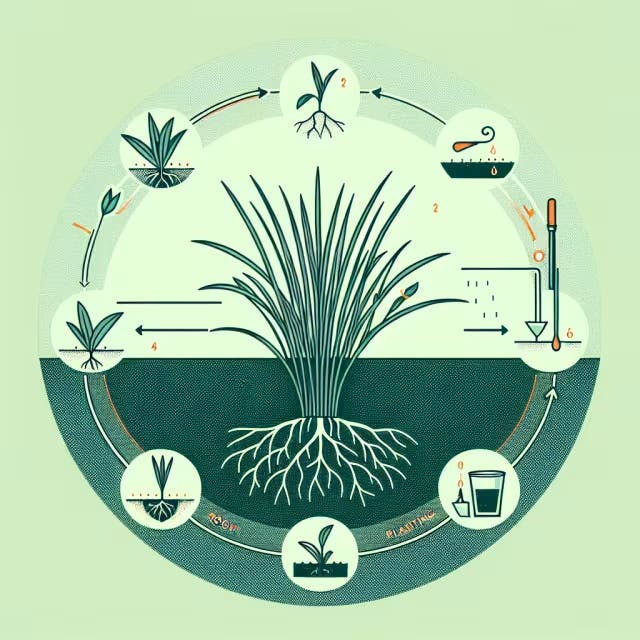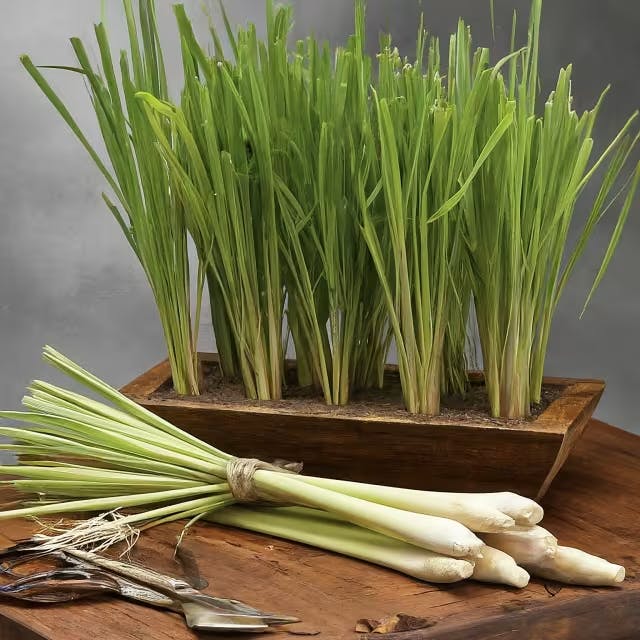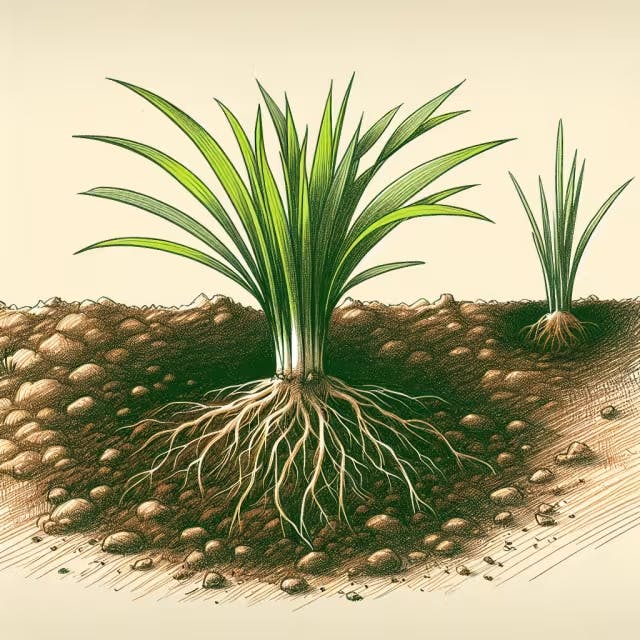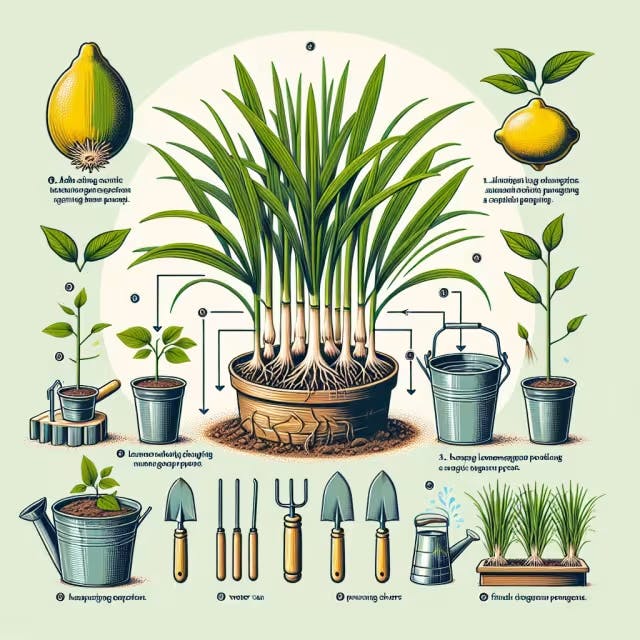How to Propagate Lemongrass Successfully
Go4Turf
February 12, 2024

Discovering how to propagate lemongrass successfully might seem daunting, but with the right conditions, this easy-to-grow herb can flourish and elevate your garden. Thriving in warm, humid climates and requiring full sun, adequate moisture, and nutrient-rich soil, lemongrass, when provided with attentive care, can grow impressively tall and serve multiple purposes—from cooking to medicinal. Whether you're in a cooler climate looking to grow lemongrass annually or aiming to harvest your own lemongrass stalks for their culinary and health benefits, this guide will walk you through everything you need to know to achieve propagation success.
Key Takeaways
Lemongrass thrives in warm, humid climates, requiring full sun, moisture, and nutrient-rich soil for successful growth.
For cooler climates, lemongrass can be grown annually with the proper care to enjoy its culinary and medicinal benefits.
Understanding the basics of lemongrass propagation is crucial for successfully growing this versatile herb.
Preparing your lemongrass correctly before propagation can significantly enhance the chances of successful growth.
Propagating lemongrass in water through a step-by-step guide allows for an easier transition to planting in soil.
Following specific tips and best practices can greatly increase the likelihood of propagation success.

Understanding the Basics of Lemongrass Propagation
To successfully propagate lemongrass, follow these simple but effective steps. First, select healthy stalks from a mature lemongrass plant. Ensure they have at least one or two visible nodes, as these are crucial for root development. Trim the top leaves to focus the plant's energy on root growth.
Next, place the stalks in a glass of water, exposing the nodes. Change the water every few days to prevent stagnation and encourage healthy root development. Within a week or two, you should see roots forming.
Once the roots are about an inch long, it's time to plant the lemongrass in soil. Choose a pot with a drainage hole and fill it with a rich, well-draining potting mix. Lemongrass thrives in full sun and requires regular watering to keep the soil consistently moist, as explained in resources from Bonnie Plants and The University of Wisconsin Division of Extension.
Remember, lemongrass is a tropical plant and prefers warm temperatures. In cooler climates, it's best to grow lemongrass in pots that can be moved indoors during winter.
By following these steps, you'll have a thriving lemongrass plant ready to be used in your favorite dishes or as an aromatic addition to your garden.

Preparing Your Lemongrass for Propagation
To ensure a successful propagation, select healthy lemongrass stalks with enough green growth. Look for stalks that are firm to the touch and have vibrant green leaves, as these are indicators of a healthy plant. Avoid any stalks that are brown or wilted, as they may not take root as effectively.
Cut the stalks about 5 to 6 inches from the root end, ensuring each piece has at least one or two nodes, as these are crucial for new growth. Place the stalks in a container filled with water, submerging them about 2-3 inches deep. Change the water every few days to prevent stagnation and promote healthy root development.
Once roots appear, typically within a week or two, transfer your lemongrass to a pot filled with a well-draining potting mix. This step is essential, as lemongrass thrives in full sun and requires rich, well-drained soil for optimal growth. Regularly water your newly potted lemongrass, keeping the soil consistently moist but not waterlogged.
For those living in cooler regions, remember that lemongrass can be overwintered indoors or grown as an annual. This flexibility allows you to enjoy fresh lemongrass year-round, regardless of your climate. Learn more about this versatile plant and how to ensure its successful growth.

Step-by-Step Guide to Propagating Lemongrass in Water
To begin propagating lemongrass in water, you'll need a stalk from an existing plant. Ensure the stalk is healthy and has some roots attached for the best results. Here's a simple, step-wise approach:
Cutting Preparation: Select a fresh lemongrass stalk with a healthy base. Trim the top to reduce evaporation and focus energy on root growth.
Root Initiation: Place the stalk in a jar filled with clear water, ensuring the base is well submerged. Use a transparent container for easy observation of root development.
Location: Position the jar in a location that receives indirect sunlight. Lemongrass thrives in warm conditions, so a warm, bright spot is ideal.
Water Change: Refresh the water every few days to prevent stagnation and bacterial growth. Clean, fresh water promotes healthier root growth.
Transplanting: Once roots are a few inches long, transplant the lemongrass into a pot with soil. This transition will encourage further growth and development.
By following these steps, you'll nurture the growth of new lemongrass plants right at home. For continued success, ensure the newly potted lemongrass is watered regularly and placed in a sunny spot. This method doesn't just simplify gardening; it also enhances your kitchen garden with a fresh supply of lemongrass.

Planting Your Lemongrass Sprouts in Soil
Once your lemongrass sprouts have developed roots, it's time to transfer them to soil, ensuring a proper environment for their growth and prosperity. Choose a potting mix that is rich in nutrients and well-draining, as lemongrass thrives in moist, but not waterlogged, conditions. Here's a simplified guide on how to do it:
Select a pot or garden spot that receives ample sunlight. Lemongrass requires full sun to grow vigorously.
Prepare the soil by incorporating compost or a balanced fertilizer to enrich it with nutrients.
Plant the lemongrass sprouts with the roots down, spacing them about 24 inches apart to allow room for growth.
Water the newly planted lemongrass immediately, ensuring the soil is moistened but not saturated.
Remember, regular watering is crucial for lemongrass, especially during hot, dry periods. However, avoid over-watering to prevent root rot, a common issue in poorly drained soils. With proper care, your lemongrass will soon start to flourish, offering not only its fragrant lemony scent but also a plethora of uses in your kitchen and garden.
For more detailed information on growing and caring for lemongrass, including how to overwinter it indoors in colder climates, visit Bonnie Plants.

Tips for Ensuring Lemongrass Propagation Success
To successfully propagate lemongrass, consider these practical steps:
Choose Healthy Parent Plants: Select robust and vibrant lemongrass stalks. This ensures a higher success rate as weaker plants might not survive the propagation process.
Cutting Preparation: When taking cuttings, ensure they are about 6 inches long and include both the root base and a few leaves. Trim the top to concentrate energy towards root development.
Rooting in Water: Place the cuttings in a glass of water, exposing only the root base. Change the water every few days to prevent bacterial growth. Roots should appear within a week or two.
Soil Transplantation: Once the roots are about an inch long, transplant the cuttings into soil. Use well-draining soil and keep it consistently moist, especially during the initial weeks after transplantation.
Adequate Sunlight: Lemongrass thrives in full sun. Ensure your propagated plants receive at least six hours of sunlight daily. In colder climates, a south-facing window is ideal for indoor plants.
Regular Fertilization: After a month of planting, start a fertilization schedule using a balanced, slow-release fertilizer. This nourishes the plant and encourages vigorous growth.
Pruning: Regularly trimming the tops of the lemongrass can promote bushier growth. Prune lightly but avoid cutting more than a third of the plant at once to prevent shock.
By following these steps, you not only learn how to propagate lemongrass successfully but also ensure robust, healthy plants that will provide you with their aromatic leaves for your culinary adventures and possibly even act as a natural repellent against mosquitoes. In conclusion, mastering how to propagate lemongrass successfully hinges on selecting the right stalks, ensuring proper rooting in water, followed by planting in nutrient-rich, well-draining soil. By following these guided steps and offering regular care, including adequate sunlight and moisture, you can enjoy a bountiful harvest of this versatile and aromatic herb. Whether grown in pots for easy winter care or in garden beds to expand your culinary arsenal, lemongrass can be a rewarding addition to your gardening endeavors.
Frequently Asked Questions
What are the ideal conditions for rooting lemongrass cuttings in water?
To successfully root lemongrass cuttings in water, select healthy stalks with green growth and firm texture, ensuring they have at least one or two nodes since these are essential for new growth. Cut the stalks about 5 to 6 inches from the root end and place them in a container filled with water, submerging the stalks about 2-3 inches deep. It's crucial to change the water every few days to prevent stagnation and to promote healthy root development. Once roots are visible and about an inch long, the lemongrass is ready to be transplanted into soil, remembering that it thrives in full sun and requires rich, well-drained soil, along with consistent moisture for optimal growth. Regular watering is necessary, especially in hot, dry periods, but avoid over-watering to prevent root rot.
How can you ensure your lemongrass thrives after transplanting to soil?
After the lemongrass roots reach about an inch long in water, it's crucial to transplant them properly to ensure healthy growth. Select a container with drainage holes and use a rich, well-draining potting mix. Plant the lemongrass in a sunny location, as it thrives in full sun, and maintain consistently moist soil without overwatering. For those in cooler climates, consider moving the lemongrass indoors during winter to protect it from cold temperatures. By following these care guidelines, including regular watering and ensuring ample sunlight, your lemongrass will flourish, enhancing your garden with its aromatic presence and offering a fresh ingredient for your culinary uses.
What steps should you take to select healthy lemongrass stalks for propagation?
To select healthy lemongrass stalks for propagation, look for ones that have a firm texture and vibrant green color, indicating robust health. Ensure each stalk has at least one or two visible nodes, crucial for root development. Trim the top leaves to channel the plant's energy towards rooting. Place the prepared stalks in a glass of water, making sure the nodes are submerged. Change the water regularly to maintain a clean environment conducive to root growth. Once the roots are about an inch long, the lemongrass is ready to be planted in soil. Choose a well-draining potting mix and ensure the lemongrass gets full sun and regular watering. This approach encourages strong, healthy plants ideal for culinary use or as fragrant garden additions.
How do you prepare lemongrass cuttings for successful propagation?
To successfully propagate lemongrass, start by selecting healthy stalks with visible nodes, which are essential for root formation. Trim the top leaves to focus the plant's energy on rooting. Place the stalks in a glass of water, ensuring the nodes are submerged, and change the water every few days to avoid stagnation. When the roots reach about an inch long, transfer the lemongrass to a pot filled with rich, well-draining soil. Ensure the pot is situated in a location that receives plenty of sunlight, as lemongrass thrives in full sun. Regular watering is crucial to keep the soil moist but not waterlogged. For those in cooler climates, consider growing lemongrass in pots that can be moved indoors during winter to maintain a warm environment and ensure year-round growth.
What are the best practices for caring for lemongrass in cooler climates?
Successfully propagating lemongrass in cooler climates involves several key steps: selecting healthy stalks with green growth and visible nodes for rooting, placing the stalks in water to encourage root development, and changing the water regularly to prevent stagnation. Once roots appear, transfer the lemongrass to pots with well-draining soil, ensuring they receive full sun and consistent moisture. For cooler regions, it's essential to bring lemongrass indoors during winter or grow it as an annual. Regular watering, well-draining soil, and ensuring plenty of sunlight are crucial. Following these steps will help you enjoy fresh lemongrass year-round.